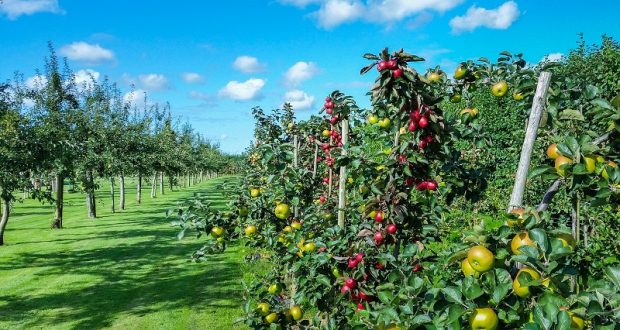By Bob Labozetta (UC Master Gardener, Mariposa)
December through March is the time to plant fruit and nut trees. Bare root trees are less expensive, transport easily and acclimate best to native soils. Once you’ve chosen your variety of bare root tree, it’s time to plant. Choose a site that gets a minimum of six to eight hours of sunlight per day. To ensure deep, well-drained soil several feet wide around the planting site, loosen the soil deeply several feet around the site.
Do NOT add fertilizer or soil amendments directly to the planting hole. Prior to preparing the hole, work well-decomposed compost into the area. Dig a hole no deeper than the tree’s roots and about twice as wide as the root’s spread. Score the sides of this hole to allow more outward growth of the roots.
Form a cone of soil in the center of the hole and spread the roots over and around the cone orienting the tree so the bud union faces the southwest. This prevents sunscald of the flat side of the trunk just above the bud union. Back-fill the hole halfway with the same soil that was excavated and gently tamp the soil to eliminate any large air pockets. The bud union should be four to six inches above the soil surface. Add some water to the hole. Finish filling the hole and firm gently again. The dirt around the tree should slope gently away from the trunk.
Unless you have a heavy clay soil, build a doughnut-shaped basin evenly around the tree slightly wider than the planting hole. Thoroughly water the tree to settle the soil around the roots and make sure the water drains away from the tree’s trunk.
Clear weeds and grasses from an area about three feet wide around the tree. Lay mulch three to six inches thick around the tree to prevent weed growth, conserve water, and keep soil temperature constant. Avoid crown rot by keeping the mulch several inches away from the tree’s trunk.
Finally, prune the tree back to a single trunk about two feet tall and paint the trunk with white interior latex paint diluted to two parts water to one part paint. This whitewash will help prevent sunscald and bark peeling that leaves the tree susceptible to wood-boring insects that can damage or kill the new tree.
When growth begins in the spring, water the tree once or twice per week and adjust the schedule depending on the amount of rainfall or ambient temperature.
UC Master Gardeners of Mariposa County are located at 5009 Fairgrounds Rd., Mariposa. For more gardening and event information, visit our website at http://cemariposa.ucanr.edu/Master_Gardener and Facebook page (UC Master Gardeners of Mariposa County.)
UC Master Gardeners staff a Helpline serving Mariposa County, including Greeley Hill, Coulterville, and Lake Don Pedro at 209-966-7078 or mgmariposa@ucdavis.edu.
Listen to us on the radio at KRYZ 98.5 FM on Wednesdays at 2 p.m. and Saturdays at 5 p.m.




